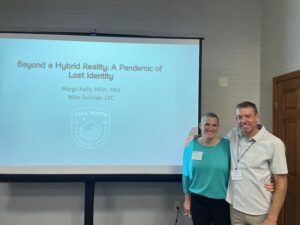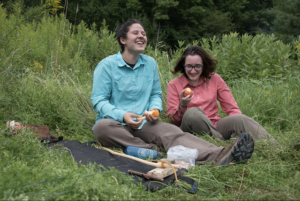
Social scientists widely agree that identity development is more complex than it was in Erik Erikson’s time. Identity exploration extends beyond adolescence, and is now a key feature of emerging adulthood (Arnett, 2021). Further, with the inception of the internet (and particularly social media and online video games), identity development now transpires within a “hybrid reality,” interactions in both the online and offline world, and the increasingly blurred boundary between the two (Granic, Morita & Scholten, 2020). We now have a generation of adolescents and emerging adults who haven’t known life without smartphones and tablets, and their experiences in the flesh are no longer functionally distinct from their experiences online. With the onset of the coronavirus and the digital surge of 2020, the world went into lock down and screen time went into hyperdrive (De, Pandey, Pal, 2020). The mental health consequences are significant and it appears that a new outbreak has emerged and spread like wildfire among adolescents and young adults: a pandemic of lost identity.
 At a professional conference in Rhode Island in October 2021, Margo Kelly, MA, MEd., and Mike Sullivan, LPC, reviewed interpersonal and intrapersonal implications of the “hybrid reality” on adolescents and emerging adults, examined the impacts of isolation and the digital surge of 2020, and explored methods for facilitating identity development with this “lost” generation. Presenters discerned between the simplification of “screen time” and instead, looked at the complexity of digital experiences youth engage with. Group participants collaborated in identifying healthy and unhealthy aspects of digital experiences, with an underlying theme emerging: “It isn’t what youth are interfacing with, it is how.” The hybrid reality isn’t going away. We are called to action to provide youth tools for navigating uncharted territory, and develop agency, self-concept, and coherence in their identity development.
At a professional conference in Rhode Island in October 2021, Margo Kelly, MA, MEd., and Mike Sullivan, LPC, reviewed interpersonal and intrapersonal implications of the “hybrid reality” on adolescents and emerging adults, examined the impacts of isolation and the digital surge of 2020, and explored methods for facilitating identity development with this “lost” generation. Presenters discerned between the simplification of “screen time” and instead, looked at the complexity of digital experiences youth engage with. Group participants collaborated in identifying healthy and unhealthy aspects of digital experiences, with an underlying theme emerging: “It isn’t what youth are interfacing with, it is how.” The hybrid reality isn’t going away. We are called to action to provide youth tools for navigating uncharted territory, and develop agency, self-concept, and coherence in their identity development.

Wilderness therapy is a particularly effective intervention in supporting identity development, particularly on the heels of the 2020 digital surge. With youth and young adults so entrenched in an online world, wilderness therapy is a complete paradigm shift- an opposite experience to the online reality they are embroidered within. Wilderness therapy occurs purely in the flesh. It provides a natural environment devoid of access to the virtual world and emphasizes face to face relationships and introspection. Margo Kelly showcased specific clinical approaches rooted in Narrative Therapy, Internal Family Systems, and experiential/somatic therapy that have proven particularly effective in identity development, followed by several case examples.
If you are interested in learning more about this particular topic or have questions/comments for presenters, please contact Mike Sullivan directly.
References:
Arnett, J. J. (2021). Emerging adulthood. In R. Biswas-Diener & E. Diener (Eds), Noba textbook series: Psychology. Champaign, IL: DEF publishers. Retrieved from http://noba.to/3vtfyajs
De’, R., Pandey, N., & Pal, A. (2020). Impact of digital surge during Covid-19 pandemic: A viewpoint on research and practice. International journal of information management, 55, 102171. https://doi.org/10.1016/j.ijinfomgt.2020.102171
Granic, Isabela; Morita, Hiromitsu; & Scholten, Hanneke (2020) Beyond Screen Time: Identity Development in the Digital Age, Psychological Inquiry, 31:3, 195-223, DOI: 10.1080/1047840X.2020.1820214
Krause, P. K. (2013). IFS with children and adolescents. In Internal Family Systems Therapy (pp. 63-82). Routledge.
White, M. K., & Morgan, A. (2006). Narrative therapy with children and their families. Adelaide, Australia: Dulwich Centre Publications.


